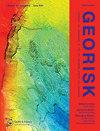GIS-Based Assessment of Fire Effects on Flash Flood Hazard: The Case of the Summer 2021 Forest Fires in Greece
IF 4.8
3区 工程技术
Q1 ENGINEERING, GEOLOGICAL
Georisk-Assessment and Management of Risk for Engineered Systems and Geohazards
Pub Date : 2022-12-23
DOI:10.3390/geohazards4010001
引用次数: 1
Abstract
Greece, like the rest of the Mediterranean countries, faces wildland fires every year. Besides their short-term socioeconomic impacts, ecological destruction, and loss of human lives, forest fires also increase the burnt areas’ risk of flash flood phenomena, as the vegetation, which acted in a protective way against runoff and soil erosion, is massively removed. Among the most severe wildland fire events in Greece were those of summer 2021, which were synchronous to the very severe heat waves that hit the broader area of the Balkan Peninsula. More than 3600 km2 of land was burnt and a significant amount of natural vegetation removed. Three of the burnt areas are examined in this work, namely, Attica, Northern Euboea, and the Peloponnese, in order to assess their risk of future flash flood events. The burnt areas were mapped, and their geological and geomorphological features studied. Flash flood hazard assessment was accomplished through a Boolean logic-based model applied through Geographic Information Systems (GIS) software, which allowed the prioritization of the requirement for protection by identifying which locations were most prone to flooding. The largest part of our study areas is characterized by geomorphological and geological conditions that facilitate flash flood events. According to our findings, in almost all study areas, the regions downstream of the burnt areas present high to very high flash flood hazard, due to their geomorphological and geological features (slope, drainage density, and hydrolithology). The only areas that were found to be less prone to flood events were Vilia and Varimpompi (Attica), due to their gentler slope inclinations and overall geomorphological characteristics. It is known that vegetation cover acts protectively against flash floods. However, in this case, large areas were severely burnt and vegetation is absent, resulting in the appearance of flash floods. Moreover, imminent flooding events are expected to be even more intense in the areas downstream of the burnt regions, possibly bearing even worse impacts on the local population, infrastructure, etc.基于gis的火灾对山洪灾害影响评估:以希腊2021年夏季森林火灾为例
和其他地中海国家一样,希腊每年都面临野火。除了短期的社会经济影响、生态破坏和人类生命损失外,森林火灾还增加了被烧毁地区发生山洪暴发现象的风险,因为对径流和土壤侵蚀起保护作用的植被被大量破坏。希腊最严重的野火事件发生在2021年夏季,与袭击巴尔干半岛更广泛地区的非常严重的热浪同时发生。超过3600平方公里的土地被烧毁,大量的自然植被被砍伐。在这项工作中考察了三个被烧毁的地区,即阿提卡、北欧洲和伯罗奔尼撒,以评估它们未来发生山洪暴发事件的风险。绘制了火灾区域分布图,研究了火灾区域的地质地貌特征。山洪灾害评估是通过地理信息系统(GIS)软件应用的基于布尔逻辑的模型来完成的,该模型可以通过确定最容易发生洪水的地点来确定保护需求的优先级。我们研究区域的大部分特征是易发生山洪暴发的地貌和地质条件。根据我们的发现,在几乎所有的研究区域中,由于其地貌和地质特征(坡度、排水密度和水文岩性),烧毁地区的下游地区存在高至极高的山洪暴发风险。唯一被发现不太容易发生洪水事件的地区是Vilia和Varimpompi (Attica),这是由于它们的坡度较小和整体地貌特征。众所周知,植被覆盖对山洪暴发有保护作用。然而,在这种情况下,大面积严重烧毁,植被缺失,导致山洪暴发。此外,在被烧毁地区的下游地区,即将发生的洪水事件预计会更加强烈,可能对当地人口、基础设施等造成更严重的影响。
本文章由计算机程序翻译,如有差异,请以英文原文为准。
求助全文
约1分钟内获得全文
求助全文
来源期刊
CiteScore
8.70
自引率
10.40%
发文量
31
期刊介绍:
Georisk covers many diversified but interlinked areas of active research and practice, such as geohazards (earthquakes, landslides, avalanches, rockfalls, tsunamis, etc.), safety of engineered systems (dams, buildings, offshore structures, lifelines, etc.), environmental risk, seismic risk, reliability-based design and code calibration, geostatistics, decision analyses, structural reliability, maintenance and life cycle performance, risk and vulnerability, hazard mapping, loss assessment (economic, social, environmental, etc.), GIS databases, remote sensing, and many other related disciplines. The underlying theme is that uncertainties associated with geomaterials (soils, rocks), geologic processes, and possible subsequent treatments, are usually large and complex and these uncertainties play an indispensable role in the risk assessment and management of engineered and natural systems. Significant theoretical and practical challenges remain on quantifying these uncertainties and developing defensible risk management methodologies that are acceptable to decision makers and stakeholders. Many opportunities to leverage on the rapid advancement in Bayesian analysis, machine learning, artificial intelligence, and other data-driven methods also exist, which can greatly enhance our decision-making abilities. The basic goal of this international peer-reviewed journal is to provide a multi-disciplinary scientific forum for cross fertilization of ideas between interested parties working on various aspects of georisk to advance the state-of-the-art and the state-of-the-practice.

 求助内容:
求助内容: 应助结果提醒方式:
应助结果提醒方式:


